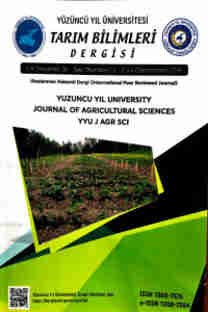Farklı besinlerin yeşilkurt, Helicoverpa armigera (Hübn.) (Lepidoptera:Noctuidae)' nın cinsiyet oranı, yumurta verimi ve ömrü üzerine etkileri
Bu çalışma laboratuvarda 25±1$circ$C sıcaklık, %65±5 orantılı nem ve 16A:8K fotoperiyot koşullannda yapılmıştır. Çalışmada yapay besin, nohut, domates ve tütün olmak üzere 4 farklı besin kullanılmış ve bu besinlerin Helicoverpa armigera (Hübn.)'nın cinsiyet oranı, yumurta verimi ve ömrü üzerinde etkileri araştırılmıştır. Yapılan çalışmalar sonucunda cinsiyet oranın (dişi:erkek) tüm besinlerde 1.0:1.0'a yakın olmasına rağmen erkekler lehine olduğu, dişilerin günlük ve toplam olarak en çok yumurtayı yapay besinde, en az yumurtayı tütünde bıraktığı, ergin dişi ve erkek ömrünün en uzun yapay besinde, en kısa nohutta sürdüğü saptanmıştır. Yapılan varyans analizi sonucunda besin farklılığının dişinin bıraktığı günlük yumurta sayısı ve erkek ömrü üzerine farklı etki yaptığı tespit edilmiştir. Diğer yandan ilk dişi ölümü yapay besin, nohut, domates ve tütünde sırasıyla 7., 14., 12. ve 17. Günlerde, ilk erkek ölümü tütünde 10., diğer besinlerde ise 7 günde tespit edilmiştir. Günlük ortalama yumurta sayısı yapay besin, nohut, domates ve tütünde sırasıyla dişi ömrünün 7., 14., 9. ve 11. günlerinde ve domates ile tütünde tüm dişiler canlı iken, yapay besinde bir, nohuttta ise iki dişi öldükten sonra en yükseğe ulaşmış ve ovipzisyon uzun tütünde sürmüştür.
Anahtar Kelimeler:
Helicoverpa armigera, Lepidoptera, yumurta döl verimi, predatörler, eşey oranı, uzun ömürlülük
Effects of different foods on the sex ratio, fecundity and longevity of bollworm, Helicoverpa armigera (Hübn.) (Lepidoptera:Noctuidae)
This study was carried out in laboratory at 25±1 0C temperature, 65±5 % RH and 16L:8D photoperiod. In the study, 4 different foods; artificial food, chickpea, tomatoes and tobacco were applied and the effects of these foods on tue sex ratio, fecundity and longevity of Helicoverpa armigera (Hübn.) were investigated. According to the results, sex ratio (female:male) was nearly 1.0:1.0 on the all foods, but it was in favour of male. The daily and total maximum eggs of female were laid on the artificial food. The daily and total minimum eggs of female were laid on the tobacco. The longest longevity of adult female and adult male were continued on the artificial food. The shortest longevity was on the chickpea. According to the variance analysis, it was determined that the difference of food affected differently adult male longevity and the number of laying daily eggs. On the other hand, the first female death was observed 7th , 14th, 12th and 17th days on articial food, chickpea, tomato and tobacco respectively, while the first male death was 10th day for tobacco and 7th day for other food. The number of daily average eggs reached the maximum level on the artificial food, chicpea, tomato and tobacco, 7th , 14th, 9th and 11th days, respectively, when all of the females were alive; on the artificial food after a female died; on the chickpea after two females died, The longest egg laying period was lasted on the tobacco.
Keywords:
Helicoverpa armigera, Lepidoptera, egg fertility, predators, sex ratio, longevity,
___
- Broadley, R.H. ve D.G. Butler, 1986. Longevity of adult Heliothis armigera (Hübner) (Lepidopğtera:Noctuidae). Journal of Maharashtra Agricultural Universities, 19 (3): 261-262.
- Chaudhary J.P. ve S.K. Sharma, 1983. Biology of Gram Podborer, Heliothis armigera (Hübner) in the Haryana State. Bull. of Entomology, 2:101-108.
- Coaker, T.N., 1959. Investigations on Heliothis armigera (Hb.) in Uganda. Bull. Of Entomology, 50, 487-492.
- Danilevskii, A.S. 1965. Photoperiodism and seasonal development of Insect.39 Webeek Street, London,92 p.
- Dimetry, N.Z., S. Elüsherif ve İ.A. İsmail, 1992. Photoperiod as extrinsic factor controlling the population in the American bollworm, Heliothis armigera (Hüb.). Bull. of the Entomological Society of Egypte Economics Series, 17, 85-92.
- Farid, A., 1989. Some bio-ecological features of Heliothis armigera Hb. on tomatoes in Djiraft. Entomologie et Phytopathologie Appliquées, 54 (1-2): 5-6.Kansu, İ.A., 1962. Besin çeşidinin tırtılların gelişmesine etkileri ve bu konuda Lymantria dispar L. (Kırtırtılı) üzerinde bir araştırma. Ankara Ün. Ziraat Fakültesi 1962 yıllığı, Sayı 2’den ayrı basım, 116-138.
- Kansu, İ.A., 1981. Hastalık ve zararlılarla savaş yoluyla bitkisel üretimin arttrılması olanakları. Türkiye II. Tarım Kongresi, Ankara, 253-292.
- Kornoşor, S., 1976. Güneydoğu Anadolu Bölgesinde Heliothis Cinsine Bağlı Türlerin Tespiti ve Bunların Morfolojik ve Genetik Özelliklerinin Araştırılması (Doktora tezi Yayınlanmamış). Ankara.
- Mourikis, P.A. ve P. Vassiliana_Alexopoulou, 1970. The behaviour of adults of Heliothis armigera (Hbn.) (Lep.:Noctuidae) feed soybean , cotton and articial diet of three temperatures. Environ Entomology, 12, 582- 589.
- Öngören, K., N. Kaya ve Ş. Türkmen, 1977. Ege bölgesinde domateslerde zarar yapan Yeşilkurt (Heliothis armigera Hüb.) ‘un morfolojisi, biyoekolojisive mücadelesi üzerinde araştırmalar. Bitki Koruma Bülteni, 17 (1) 3.
- Shorey H.N. ve R.L. Hale, 1965. Mass-Rearing of the larvae of nine Noctuid species on a simple artificial medium. Journal Econ.Entomology, 58, 522-525.
- Tripathi S.R. ve S.K. Sharma, 1985. Biology of Heliothis armigera (Hübner) (Lep.:Noctuidae) in the Treai Belt of eastern Utter Pradesh. Indian Journal of Entomology, 50 (1):76-81.
- Trıpathı, S.R. ve S.K.Sharma, 1989. Effect of some food plants on development and growth of pod borer Heliothis armigera (Hübner) (Lepidoptera:Noctuidae). Nigerian Journal of Entomology, 6 (1-2): 33-38.
- Yabaş, M.N., 1979. Çukurova Bölgesinde Helicoverpa Cinsine Giren Armigera ve Zea Gruplarının Biyoekolojileri (Doktora tezi, yayınlanmamış). Adana.
- ISSN: 1018-9424
- Yayın Aralığı: Yıllık
- Başlangıç: 2018
- Yayıncı: -
Sayıdaki Diğer Makaleler
Nuran KAYABAŞI, H. Sinem ŞANLI, SEMA ETİKAN
Effect of potassium on emergence and seedling growth of cucumber grown in salty conditions
ÖNDER TÜRKMEN, SUAT ŞENSOY, İBRAHİM ERDAL
Kentsel arıtma çamırunun tarımda fosfor kaynağı olarak kullanılması
K. Mesut ÇİMRİN, MEHMET ALİ BOZKURT, İBRAHİM ERDAL
Van yöresinde yetişdirici şartlarında depolanan kaba yemlerde aflatoksin oluşumunun saptanması
